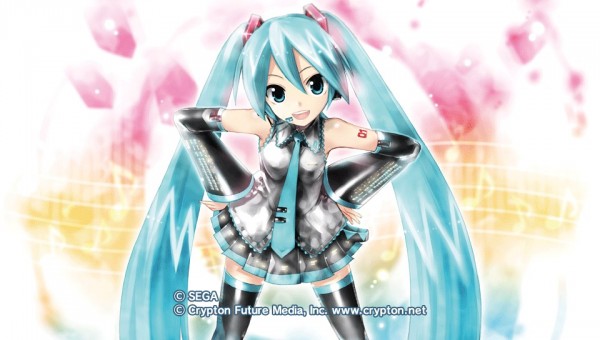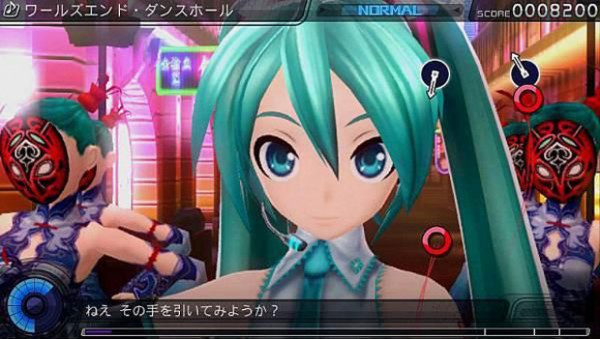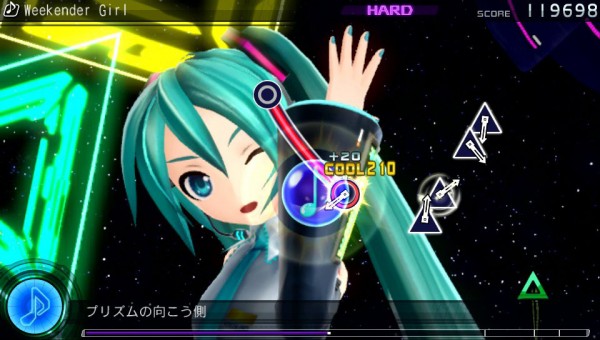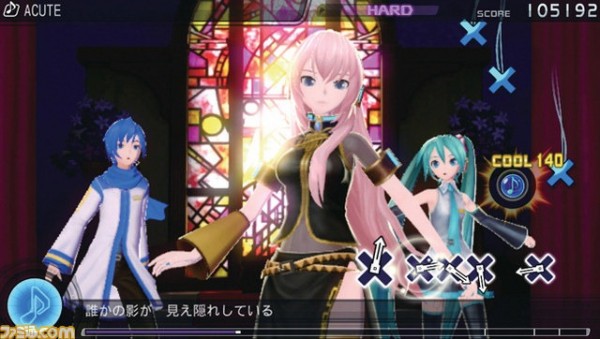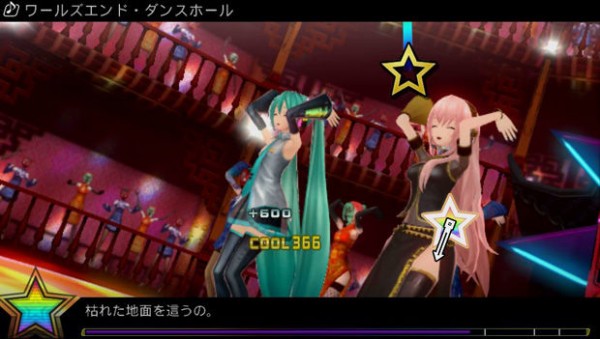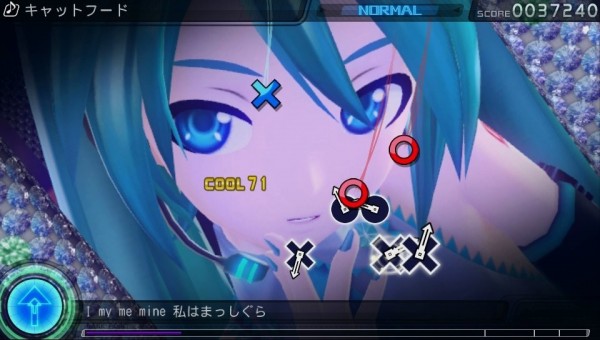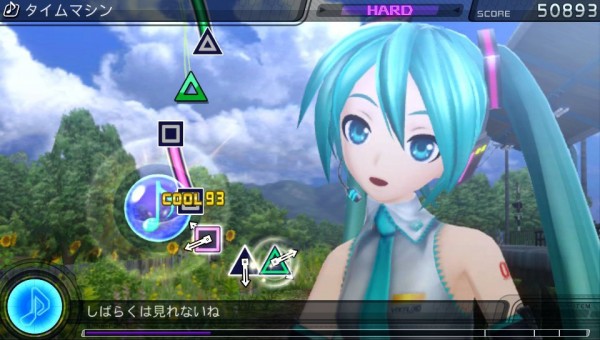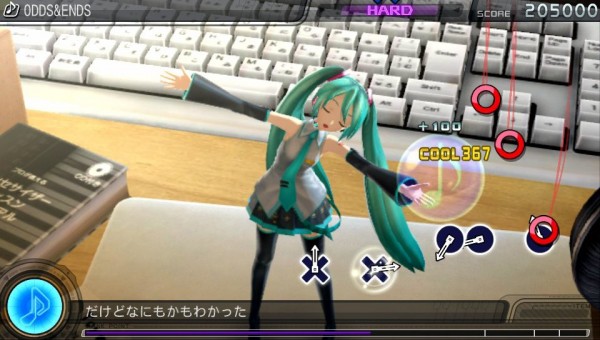This week I am doing something different by looking at a game that has yet to officially be released in America. When I decided to import Hatsune Miku: Project Diva f, I didn’t do it because I was a fan of Miku and her fellow Vocaloids. In fact, when I purchased this game I was at best a tertiary fan, only liking the characters for their designs. What made me drop money on this game was I kept hearing from people how this game was one of the best games for the PS Vita to not be released in the West. Well, those people weren’t wrong.
Project Diva f is a music game that is more in line with the great Elite Beat Agents than say Guitar Hero and its ilk. The primary gameplay in Project Diva f involves hitting color coded notes in sync with the beat of the song whilst an animated music video plays in the background. The notes in Project Diva f take the form of the Vita’s face buttons, colored arrows that require you to press a face button and its corresponding d-pad direction at the same time, and stars that you must swipe the Vita’s touchscreen to hit.
Depending on how accurately you time your input each note can have one of five ratings; Cool, Fine, Safe, Sad, and Worst. Cool being the best rating and Worst meaning you completely missed the note. Earning Cool and Fine ratings add to a progress bar at the bottom of the screen and to your health meter, as well as increase your score. Earning Safe ratings does nothing beyond breaking your note streak. Earning Sad ratings takes away from your health, and earning Worst ratings takes away health and the vocals of the song are muted briefly.
Interestingly, Project Diva f has it to where you can finish a song but still not pass it. You must pass a certain point on the progress bar to pass a song, upon which you will then be given one of four grades for clearing the song; Standard, Great, Excellent, or Perfect. The only way to flat out fail a song is if you get enough Worst ratings to deplete your health meter. There are four difficulty settings to play the game on; Easy, Normal, Hard, and Extreme. Each setting adds more notes onto the screen and speeds up the time you have to hit them.
During each song there are two special groups of notes, the Technical Zone and the Chance Time. In the Technical Zone, a number of notes will be posted in the corner of the screen and hitting all the notes successfully will earn you a massive boost in score and progress. In Chance Time an unspecified number of notes will appear, all having a rainbow streak behind them. Hitting these notes builds up a star meter that will also give you a massive boost in progress and score if you successfully hit the resulting star note.
In addition to playing songs, there is an Edit Mode, an AR Mode, and the Diva’s Room. The Edit Mode is where you can put together your own note layouts to both the songs in the game and any songs stored on the system. Players can also edit the videos that accompany these songs. The AR Mode allows you to view an AR model of Miku perform some songs and allows you to take AR pictures with Miku where you can pick her pose, expression, and other things. The Diva’s Room is a side function that lets you interact with the different Vocaloids in their own personal rooms.
Playing songs, whether you successfully clear them or not, rewards you with Diva Points. The amount given, however, does depend on if you clear a song and on the song’s difficulty setting. Diva Points can be spent on things ranging from new different costumes for the characters called modules to items meant to decorate the various Diva’s Rooms.
Visually, the game looks stunning. The game’s music videos shine on the Vita’s OLED screen, which is even more obvious when you watch the videos in their PV, or Promotional Video, mode, where they aren’t cluttered by the onscreen notes from the gameplay mode. The music videos can be best described as belonging to one of two categories; either they prominently feature the singer dancing and singing, or they tell a story based on the song playing over the video. The animation is top notch with characters dancing all over the screen with fluid motions. The game’s dozens of loading screens are also really well drawn. In addition, the game’s interface is so intuitively put together, that despite the fact that I can’t read Japanese, I had no problem finding my way around the game after a very small amount of trial and error.
In regards to the music, this being a music game, it is overall great. There are 33 playable songs on the game, with another song restricted to the game’s tutorial and Edit Mode, and four more songs that are reserved for the AR Mode. The songs themselves range from techno pop songs to rock songs to slow ballads. I enjoyed each of the songs to various degrees, with the following three being my main favorites.
There isn’t much fault I can find with this game beyond it seeming a bit conflicted on whether it wants to be a sickenly cute game or a game full of fanservice. Some of the songs feature suggestive dancing, while some of the modules for the female characters and the loading screens are a bit revealing. It isn’t a deal breaker, and it perfectly fits the game’s CERO rating, it is just a bit jarring to go from a song bursting at the seams with saccharine sweetness one minute to a song with zoom ins on the female characters’ chests or them softly caressing their faces another minute.
That being said, the game is still insanely fun to play, and the music is really catchy. I went into this game not a fan of the Vocaloids, but after playing this game, I must say that I’ve converted. This game isn’t just one of the best Vita games to not come out to the West yet, it is one of the best Vita games period. Anyone with a Vita and wanting more games to play on it, import this game stat!
Hatsune Miku: Project Diva f is rated CERO C for ages 15+. It was released on August 30th, 2012 for the PlayStation Vita.

